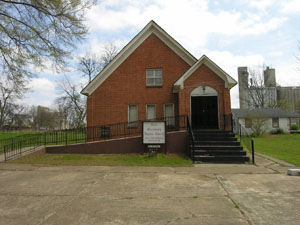Listed in Arkansas Register of Historic Places on 08/05/09
SUMMARY
The First Missionary Baptist was founded as the Colored Missionary First Baptist Church of Brinkley in 1875. The church’s first built frame was erected
in the late 1890s, and was destroyed and rebuilt in 1909. It has lasted since and continues to be a source of community to the Brinkley’s African American
Baptist members. The First Missionary Baptist is being submitted to the Arkansas Register of Historic Places for nomination under Criteria A and C
with local significance for its association with African-American religion in Brinkley and for its Gothic Revival influenced architecture. Because
it is still the home of an active and vibrant church community it is also being submitted under Criteria Consideration A: Religious Properties.
ELABORATION
The First Baptist Church was established in 1875, soon after Brinkley was chartered as a town in 1872. Dempsey Harris, Reverend J.T. Goodall, Reverend W.M. People, Reverend Dudley, Reverend Westmoreland, Mrs. Maggie Westmoreland, Mrs. Arch Humphrey, Mrs. Millie Siratt Harris, Mrs. Josephine Lynch, Mr. John L. Lynch, Mrs. Mollie Lynch, Miss Jessie Lynch, Mrs. Sue Chambers, and Mrs. Anna Jackson formed a congregation that became the Colored Missionary First Baptist Church of Brinkley.
The first church was built near the old saw mill owned by Black and Gunn, north of the Rock Island Railroad. The site was changed after a few years to the present site of the church. Reverend John A. Harris was the first pastor.
The Reverend H.R. McMillian was called to First Baptist in the late 1880s and early 1890s. It was under his leadership that the first building was razed and a wood-framed building was erected in the Gothic Revival style. The cornerstone was laid in 1899. In the early 1900s the church was renamed to the First Missionary Baptist Church and Reverend S.S. Odom was called to take charge in 1905.
On March 8, 1909, the frame structure was destroyed by an F4 tornado. The storm passed and the effort to rebuild began the same year, with relief funding that came from across the state. With the help of the Negro State Baptist Convention, a call was issued for donations from all the state’s black churches. An article in Brinkley’s historical journal states, “All colored churches in the state of Arkansas and elsewhere are hereby requested to take a collection on Sunday morning the 14th and send it to Rev. Case J.D. Humphrey at Brinkley to aid the relief committee in charge of the sufferers at Brinkley who have been rendered homeless and penniless by the terrible cyclone which destroyed the city on Monday night.”
Under the supervision of Reverend S.S. Odom and the help of the congregation and Brinkley’s community, a red brick church building was constructed in 1909. The completed church was in the Gothic Revival style, with a high-pitched roof, Gothic stained glass, pointed windows, with wooden tracery, and an asymmetric vestibule on the side of the front façade.
Reverend Odom resigned in July 1926 and Reverend W.S. Hayes was called as the pastor in October 1926, he served until1957. Under Reverend Hayes’s leadership pulpit furniture and pews were provided. In 1967, Reverend M.E. Braceley oversaw the addition of the educational annex that was built on to the rear of the church, which was completed in 1975, along with the remodeling of the church’s façade. Reverend H.M. Wofford would re-sheath the roof with updated asphalt shingles and provide new rostrums by 1996. Paul G. Pighee, Sr. later installed wall to wall carpeting, ceiling fans, a new communion set, furniture in the pastor’s study, a spotlight, and an outside sign. Reverend Edward Smith replaced the gas space heaters with central heating and air, updated the wooden entry doors with storm doors for security, added more ceiling fans, and configured the annex with an office and kitchen accessories. Reverend Smith continued renovations to the church by refitting a baptismal pool under the choir, and have a handicapped access ramp added to the main entrance. At this time renovations continue to be made.
First Baptist has had a significant impact on the community in that it partakes in a great deal of community outreach. Not only does First Baptist reach out to the community with the gospel of Christ, but they also provide assistance to the community by providing basic needs/necessities, as well as, sharing and embracing the community with love and hospitality. They also mentor the youth and provide extracurricular activities for their physical being. The congregation provides guidance, advice and transportation for those seeking rehabilitation from strong addiction/dependency problems. They aid individuals in need of shelter and clothing by connecting them with the correct organizations. Finally, the congregation offers a variety of counseling sessions, such as marriage, divorce, depression, family issues, etc. The congregation’s goal is to strengthen the community through their many outreach options.
SIGNIFICANCE
The First Missionary Baptist was founded as the Colored Missionary First Baptist Church of Brinkley in 1875. The church’s first built frame was erected
in the late 1890s, and was destroyed and rebuilt in 1909. It has lasted since and continues to be a source of community to the Brinkley’s African American
Baptist members. The First Missionary Baptist is being submitted to the Arkansas Register of Historic Places for nomination under Criteria A and C
with local significance for its association with African-American religion in Brinkley and for its Gothic Revival influenced architecture. Because
it is still the home of an active and vibrant church community it is also being submitted under Criteria Consideration A: Religious Properties.
BIBLIOGRAPHY
Brinkley Centennial Yearbook 1872-1972, Sponsored by: Brinkley Business and Professional Women Club, in cooperation with Brinkley Chamber of Commerce.
Central Delta Depot Museum, Director Bill Sayger 870-589-2124.
Central Delta Historical Journal, 1997, February, Pg. 19.
United States Census Bureau, 2000, Monroe County.
